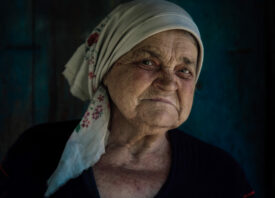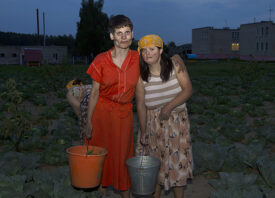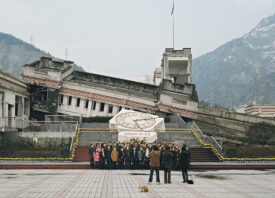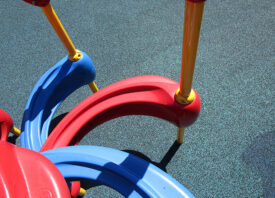Search this site
The Ongoing Cost of the Chernobyl Disaster

Olia and Ania during their inpatient treatment in the Pediatric Clinic of Neurosurgery in Kiev. The 14-year-old Olia is affected by an osteosarcoma, the most common form of primary bone cancer. In this moment she films her same age guitar playing friend, which is hospitalized because of thyroid and ovarian cancer.
National Institute of Cancer at the Pediatric Clinic of Neurosurgery, in cooperation with the Zaporuka NGO, Kiev, 2015.

A fox roams the streets of Pripyat.
After the nuclear disaster, which spread hundreds of thousands of tons of radioactive material into the air, many people assumed that the area around Chernobyl would remain for a long time a dead zone. But meanwhile not only dense forest grows rampantly here. There have also been observed animals, which otherwise in many parts of Europe are still hard to find. Besides wolves, foxes, wild boars or deer also elks and lynxes and even bears inhabit the area in which the radioactivity according to researches is still increased by ten to one hundred times.
Pripyat, Chernobyl Exclusion Zone, 2015.
“You are facing the end of humanity.” Pierpaolo Mittica is describing his emotional reaction each time he returns to Chernobyl to work on his project, Chernobyl 30 Years After. He has visited the Chernobyl Exclusion Zone (an area designated to control and limit the spread of radioactive fallout since the disaster) more than 15 times since 2002, and has been working on this particular photographic project since 2014. “Every time I go to Chernobyl it is a new experience. The feelings and the emotional level are very high, because a nuclear accident is the end of everything.”
Mittica’s work in the area began when he was commissioned by an Italian NGO to photograph the region. With this project, his focus is “not only on the consequences of the nuclear accident but more on the “normal” life that still exists inside the Chernobyl Exclusion Zone.” The area is inhabited by 4000 people, “full of life,” and Mittica has returned to the area, seeking out its hidden stories. “I want to show what remains after a nuclear accident, its consequences on the environment and on the health of the people. And to show how people are struggling to go on with their life in such a harsh environment.”
His vision is bleak. Cool tones predominate, even when depicting a lushly overgrown fairground or a blue-skied day; the environment cannot escape the memory of the disaster. Even in a project that seeks out the life of a place, the destruction colours everything. A fox snarls up from the road, a baby is viewed at close range, its face distorted by life support equipment; at times, the images feel too brutal. Our first sight of people in Mittica’s project is in a hospital context, depicting the inevitable and tragic human cost to Chernobyl. However, later, hints at regeneration are made. Despite the weary head of a worker leaning against his arm on the dashboard of his car, the efforts of industry are apparent: people are at work, and life is moving, further from the nuclear meltdown of 1986 and towards a better, healing Chernobyl (though the site will remain radioactive for 100,000 years).
Shooting digitally with a Nikon D800, Mittica considers photojournalists to be messengers. Photojournalism exists “to give voice to the people who have no voice and to give a consciousness to the public opinion.” His images, as arresting as they are desolate, allow no room for a lack of consciousness in their viewer. We watch as the effects of the disaster on Chernobyl remain to be felt devastatingly, while its inhabitants carry on, slowly and minutely moving towards a future that can only be better than the past 30 years.

An employee of the Chernobyl Nuclear Power Plant inside the damaged control room of reactor no. 4, in which once the disaster was triggered, which has been widely regarded as the worst accident in the history of nuclear power in the world: On Saturday, April 26, 1986, here there was a meltdown and explosion of the reactor core, whereby the block was completely destroyed. After the disaster it has been enclosed in a concrete and lead sarcophagus. Since then the access is limited to certain workers only. The levels of radioactivity inside the control room of reactor no. 4 are 30 times higher than the normal level.
Chernobyl Nuclear Power Plant, reactor no. 4, 2015.

Forest and wildfires are raging nearby the as a result of the reactor accident in 1986 evacuated and since then abandoned and neglected city of Pripyat.
Fires are among the greatest threats which exists in the Chernobyl Nuclear Power Plant Zone of Alienation. Through the fires radioactively contaminated trees and woods are burned. The resulting radioactive ashes are spread into the atmosphere provoking a new fallout.
On April 27, 2015, there was one of the largest forest fires in the restricted area, which was built in 1986 with a radius of 30 km around the wrecked reactor block no. 4 of the Chernobyl Nuclear Power Plant on the territory of Ukraine. More than 113 square kilometers of radioactive contaminated forest were affected, throwing back tons of radioactive particles into the air.
Pripyat, Chernobyl Exclusion Zone, 2015.

The Ferris wheel in Pripyat hidden by nature.
The fairground with the still existing Ferris wheel and dodgems is located in the heart of the city. It was supposed to be opened for the first time on May 1, 1986, in time for the May Day celebrations. However, due to the nuclear power plant disaster this did not happen. On April 27 the whole city was evacuated. Today, 30 years after the evacuation, the traces of abandonment are everywhere visible. The city resembles a ghost town. But in in the desolation life is stirring: Despite the high contamination of the area nature has gradually regenerated itself, albeit in a mutated form. The absence of humans for so many years has given place to the vegetation to develop itself in a completely uncontrolled way. Squares and districts which once were populated by employees of the nuclear power plant today are submerged by dense forest.
Pripyat, Chernobyl Exclusion Zone, 2014.

A doll left behind in the kindergarten “Zolotoj Kluchik” of Pripyat.
Pripyat was founded on 4 February 1970 and was built at the eponymous river only about four kilometers far away from the nuclear plant in Chernobyl. Once the city was the residence of many employees of the nuclear power station and their families. The city grew rapidly; the residents were young and relatively prosperous. At the time of the disaster in 1986 lived here already about 50 000 inhabitants, all of whom have not been evacuated until 36 hours after the reactor accident, on April 27. That’s why many local residents were exposed a high radiation. Many suffered the long-term consequences. In the few hours in which the city was evacuated almost no one of the residents knew that he would never return. Besides important documents and the most necessary things which they were allowed to take with them, the residents left everything behind. What isn’t already decayed or was looted, can partially be visited still today in the original state. In many places there are still books, photographs, toys or dolls, which as silent contemporary witnesses keeps on to hold vigil.
Pripyat, Chernobyl Exclusion Zone, 2014.

Anna, six months old, suffers from hydrocephalus.
It is a medical condition in which there is an abnormal accumulation of cerebrospinal fluid in the brain. It was once informally called “Water on the brain” and is one of the most common pathologies caused by accumulation of radioactive particles in the fetus.
According to the Neurosurgery Institute, National Ukrainian Medical Academy in Kiev, after the nuclear disaster 98% of central nervous system anomalies were due to hydrocephalus. The average annual increase in central nervous system defects was about 39% among 2209 registered cases in the period from 1981 to 1985 compared with 4925 cases from 1987 to 1994. From 1987 to 2004 the incidence of brain tumors in children up to three years of age doubled and in infants it increased 7.5-fold.
In the picture you can see Anna on the surgery bed before the operation, in which the liquor in her brain will be reduced.
Pediatric Clinic of Neurosurgery, Kiev, 2015.

Radinka, Provinz von Ivankow, 2015.
Vladik, 7 years old his one year younger brother Igor live with their family in a small village called Radinka. Even if it lies 300 m outside of the restricted area, it’s still highly contaminated.
The medical scientist Prof. Dr. Yuri Bandajevski from the Coordinating and Analytical Center “Ecology and Health” in the last four years conducted many clinical studies to explore the impact of the through food or inhalation absorbed radioactive substances to the health of those children, who live in Radinka and other villages of the province of Ivankov. 80% of the 3700 examined children, who live close to the border of the Exclusion Zone, are suffering from heart rhythm disorders, which are directly related to the amount of cesium incorporated in their bodies. Besides that, at about 30% of children were larger quantities of the radioactive isotope 137Cs detected in the body; partially over 50 Bq per kilo; exactly that level in which any kind of disease can be developed.
Radinka, province of Ivankov, 2015.

Chernobyl is located in Polesia, a national region rich in rivers and lakes. Through the evacuation zone around the power plant flow rivers like Prypiat, Uzh, Sachan, Braginka, Glinitsa. Many large cooling basins of the power station, oxbow lakes and reservoirs are situated here. Especially in the first two weeks after the reactor accident many spring water, marsh and water protection areas have suffered a strong radionuclide contamination. Even today many waters present a high amount of radioactive materials which are particularly accumulated by the ground segments. Only the measured values of cesium-137 are at 11 to 30 million Bq/ m2 (the security level is below 2000 Bq/ m2). In the course of the years the radionuclides pass through numerous outlets in the only a few kilometers distant reservoir of Kiev and thus in the Dnieper, which supplies 30 million people with water.
Chernobyl river port, Chernobyl Exclusion Zone, 2015.

In a factory in the Exclusion Zone, located only a few kilometers away from the nuclear reactor in Chernobyl, radioactive contaminated scrap metals are recycled.
The material is collected in the whole region: a large part comes from the disused railway tracks and the vehicles that were left in the restricted area. But the scrap metals are purloined also at the port of Chernobyl or removed from the reactor units 1, 5 and 6. Subsequently, the radiation values are measured and the metal surfaces sandblasted until all impurities and radioactive substances were grinded away, what means that the metals do not exceed any more the current permitted radiation levels. After the decontamination process the recycled metals are mostly sold to Ukrainian companies. Also for foreign companies it is a lucrative business to participate in the auctions and to acquire the metals for up to 30% below the market price.
Chernobyl Exclusion Zone, 2015.

Pavel, one of the metal workers, repairing an engine in the factory where radioactive metal scraps are recycled.
It is estimated that within the Exclusion Zone are distributed one million tons of scrap irons and metals with a value of about one billion dollars. A source of income that especially in economically difficult times did not remain unnoticed. After tons of material were smuggled more or less illegally outside the restricted area, in 2007 the Ukrainian government legalized the recycling of radioactively contaminated scrap metals based on sandblasting. According to official estimates since then about 40 000 tons of recycled metals were exported from the Zone of Alienation.
Chernobyl Exclusion Zone, 2015.

A worker passing the “golden corridor”, the passage between reactor units 2 and 3 of the wrecked power station. It got his nickname because of its coating of thick lead and zinc plates which were attached due to high radioactive contamination after the nuclear accident. The radiation values are still today 30 times higher than the normal level.
Chernobyl Nuclear Power Plant, 2015.

Employees working in the control room of reactor no. 2 inside the Chernobyl Nuclear Power Plant. The power station is currently undergoing a decades-long decommissioning process of the reactors no. 1, 2 and 3, which continued operation for years following the accident at reactor no. 4. Even if the last block has been removed from the network in 2000, up to the year 2065, when the nuclear power plant is finally scheduled to be demolished, workers have to continue monitoring and maintenance.
Chernobyl Nuclear Power Plant, unit 2, 2015.

A worker involved in the construction of the New Safe Confinement taking a nap in his truck.
A consortium of western companies is building the movable enclosure that will be shifted over the wrecked reactor and cover its fragile sarcophagus in order to prevent further contamination. The secondary goal is to allow a future partial demolition of the old structure.
After the end of construction the New Safe Confinement will have a span of 257 m, a length of 162 m and a height of 108 m. The completion of the project is scheduled for November 2017. The total cost is estimated to be around 1,5 billion euro.
The “new sarcophagus” has been designed for a lifetime of 100 years.
Chernobyl Nuclear Power Plant, 2015.

Fresh painted warning signs concerning radioactive substances or ionising radiations are ready for the distribution inside the restricted area, which was established around the site of the wrecked reactor block of the Chernobyl Nuclear Power Plant.
In the ghost town of Pripyat there is a workshop where workers repair and renew the damaged warning signs, worn by time and weather. After repair they can be installed to indicate the most contaminated and dangerous places. A job, which, considering the rate of decay of the various radioactive substances, probably still have to be done for thousands of years.
Pripyat, Chernobyl Exclusion Zone, 2015.
All photographs (C) Pierpaolo Mittica.



